Research on Hydraulic Fracturing Technology for Roof Stratigraphic Horizon in Coal Pillar Gob-Side Roadway
Abstract
1. Introduction
2. Lab-Scale Hydraulic Fracturing Tests
2.1. Experimental Apparatus and Procedure
2.2. Rock Mechanical Properties
2.3. Analysis of the Results
2.4. Discussion of the Results
3. Field Test
3.1. Geological Background
3.2. Engineering Background
3.3. Analysis of the Results
- (1)
- Cutting the roof to relieve pressure artificially disrupts the roof rock strata, causing changes in its structure. After roof cutting, the continuity of the roof rock strata, which are originally intact and under high stress, breaks, and its hanging roof effect is weakened. The average resistance of the supports in the fracturing area is significantly lower than that in the middle and upper sections of the working face, with a particularly noticeable decrease when compared to the middle section excavation direction.
- (2)
- The average resistance of the supports in the working face begins to decrease before the fracturing zone fracture, indicating that the influence area of fracturing extends more than 34 m along the inclination projection direction of the fracturing drilling hole in the working face.
- (3)
- Based on four sets of recorded data, when the working face excavated 100 m, the average resistance of the supporting structure in the upper part of the working face is 7253.1 kN, in the middle part it is 8690.2 kN, and in the fractured area it is 5486.0 kN. The support resistance in the pressure relief area is reduced by 24.3% and 36.8% compared to the upper and middle sections of the working face, which indicates a good pressure relief effect.
4. Conclusions
Author Contributions
Funding
Institutional Review Board Statement
Informed Consent Statement
Data Availability Statement
Conflicts of Interest
Nomenclature
| E | elastic modulus, Pa |
| σH | the maximum horizontal principal stress, Pa |
| σh | the minimum horizontal principal stress, Pa |
| σv | the vertical stress, Pa |
| σ3 | the minimum principal stress, Pa1 |
References
- Fu, Q.; Yang, J.; Gao, Y.; Li, C.; Song, H.; Liu, Y.; Wu, X. Combined blasting for protection of gob-side roadway with thick and hard roof. J. Rock Mech. Geotech. Eng. 2024, 16, 3165–3180. [Google Scholar] [CrossRef]
- Chao, Z.; Baiquan, L.; Fei, L.; Shuai, Z.; Feifei, L. The Research of Quaternity of Drilling-Blasting-Fracturing- Extracting Technology and Application of Outburst. Procedia Eng. 2011, 26, 449–456. [Google Scholar] [CrossRef]
- Li, C.; Yang, R.; Zuo, J.; Xie, P. Theory and field tests of innovative cut blasting method for rock roadway excavation. Tunn. Undergr. Space Technol. 2025, 155, 106180. [Google Scholar] [CrossRef]
- Zou, J.; Wu, K.; Zhang, X.; Zhu, J.; Zhou, Z.; Zheng, F.; Xie, H.; Jiao, Y.-Y. Effective evaluation of deep-hole blasting for controlling strong tremors induced by deep coal mining—A case study. Int. J. Rock Mech. Min. Sci. 2022, 159, 105211. [Google Scholar] [CrossRef]
- Zhang, Q.; He, M.; Wang, J.; Guo, S.; Zhu, C.; Tao, Z.; Wang, C. Investigation of a non-explosive directional roof cutting technology for self-formed roadway. Int. J. Min. Sci. Technol. 2022, 32, 997–1008. [Google Scholar] [CrossRef]
- Yang, L.; Yang, A.; Chen, S.; Fang, S.; Huang, C.; Xie, H. Model experimental study on the effects of in situ stresses on pre-splitting blasting damage and strain development. Int. J. Rock Mech. Min. Sci. 2021, 138, 104587. [Google Scholar] [CrossRef]
- Liu, J.; Wang, H.; Yuan, Z.; Fan, X. Experimental Study of Pre-splitting Blasting Enhancing Pre-drainage Rate of Low Permeability Heading Face. Procedia Eng. 2011, 26, 818–823. [Google Scholar]
- Jiang, K.; Deng, S.; Li, Y.; Li, H. Calculating the number of radial cracks around a wellbore fractured by liquid CO2 phase transition blasting technology. J. Rock Mech. Geotech. Eng. 2024, 16, 4515–4531. [Google Scholar] [CrossRef]
- Zhu, B.; Jiang, N.; Yao, Y.; Luo, X. SPH numerical simulation of SC-CO2 directional fracturing and emulsion explosives for rock breaking. Gas Sci. Eng. 2024, 124, 205277. [Google Scholar] [CrossRef]
- Cao, Y.; Zhang, J.; Zhang, X.; Liu, S.; Elsworth, D. Micro-fractures in coal induced by high pressure CO2 gas fracturing. Fuel 2022, 311, 122148. [Google Scholar] [CrossRef]
- Habib, K.-M.; Vennes, I.; Mitri, H.S. Methodology for the estimation of expansive cement borehole pressure. Int. J. Min. Sci. Technol. 2023, 33, 73–81. [Google Scholar] [CrossRef]
- De Silva, V.R.S.; Konietzky, H.; Ranjith, P.G.; Manatunga, U.I. Strain energy dependent numerical simulation of rock fracture initiation and propagation using soundless cracking demolition agents (SCDA): Effects of SCDA-filled rock joints. Int. J. Rock Mech. Min. Sci. 2024, 177, 105740. [Google Scholar] [CrossRef]
- Xu, J.; Zhai, C.; Qin, L.; Yu, G. Evaluation research of the fracturing capacity of non-explosive expansion material applied to coal-seam roof Rock. Int. J. Rock Mech. Min. Sci. 2017, 94, 103–111. [Google Scholar] [CrossRef]
- Qin, J.; Xian, C.; Zhang, J.; Liang, T.; Wang, W.; Li, S.; Zhang, J.; Zhang, Y.; Zhou, F. Characteristics of hydraulic fracture network in the tight conglomerate reservoir based on a hydraulic fracturing test site. Pet. Explor. Dev. 2025, 52, 245–257. [Google Scholar] [CrossRef]
- Yin, W.; Feng, Z.; Zhao, Y. Effect of fracture backfill on the hydraulic fracturing behaviour of deep granite under high-temperature and high-pressure conditions: Implications for hot dry rock geothermal mining. Renew. Energy 2025, 243, 122507. [Google Scholar] [CrossRef]
- Zhou, H.; Huang, X.; Jiang, L.; Shen, Q.; Sun, H.; Yi, M.; Wang, X.; Yao, X.; Wu, Y.; Zhang, C.; et al. Improved degradation of petroleum contaminants in hydraulic fracturing flowback and produced water using laccase immobilized on functionalized biochar. Environ. Technol. Innov. 2023, 32, 103280. [Google Scholar] [CrossRef]
- Aliu, A.O.; Guo, J.; Wang, S.; Zhao, X. Hydraulic fracture fluid for gas reservoirs in petroleum engineering applications using sodium carboxy methyl cellulose as gelling agent. J. Nat. Gas Sci. Eng. 2016, 32, 491–500. [Google Scholar] [CrossRef]
- Wang, X.; Wu, W.; Wang, X.; Song, Z.; Sheng, J.J. Numerical investigating oil-water flow in shale oil reservoirs accounting for fracture swarms and injected hydraulic fluids. Geoenergy Sci. Eng. 2025, 247, 213717. [Google Scholar] [CrossRef]
- Guanhua, N.; Hongchao, X.; Zhao, L.; Lingxun, Z.; Yunyun, N. Improving the permeability of coal seam with pulsating hydraulic fracturing technique: A case study in Changping coal mine, China. Process Saf. Environ. Prot. 2018, 117, 565–572. [Google Scholar] [CrossRef]
- He, Q.; Suorineni, F.; Ma, T.; Oh, J. Effect of discontinuity stress shadows on hydraulic fracture re-orientation. Int. J. Rock Mech. Min. Sci. 2017, 91, 179–194. [Google Scholar] [CrossRef]
- He, Q.; Suorineni, F.; Ma, T.; Oh, J. Parametric study and dimensional analysis on prescribed hydraulic fractures in cave mining. Tunn. Undergr. Space Technol. 2018, 78, 47–63. [Google Scholar] [CrossRef]
- He, Q.; Zhu, L.; Li, Y.; Li, D.; Zhang, B. Simulating Hydraulic Fracture Re-orientation in Heterogeneous Rocks with an Improved Discrete Element Method. Rock Mech. Rock Eng. 2021, 54, 2859–2879. [Google Scholar] [CrossRef]
- Gao, S.; Congo, T.; Jing, Z.; Aziz, S.; Balucan, R.; Zhu, Z.; Pell, S.D.; Steel, K.M. Oxidative effects of gaseous oxygen and ozone on Australian subbituminous and bituminous coals and the implications for coal seam permeability enhancement. Gas Sci. Eng. 2023, 118, 205092. [Google Scholar] [CrossRef]
- Zhuang, J.; Mu, Z.; Cai, W.; He, H.; Hosking, L.J.; Xi, G.; Jiao, B. Multistage hydraulic fracturing of a horizontal well for hard roof related coal burst control: Insights from numerical modelling to field application. Int. J. Min. Sci. Technol. 2024, 34, 1095–1114. [Google Scholar] [CrossRef]
- Huang, B.; Liu, C.; Fu, J.; Guan, H. Hydraulic fracturing after water pressure control blasting for increased fracturing. Int. J. Rock Mech. And. Min. Sci. 2011, 48, 976–983. [Google Scholar] [CrossRef]
- He, Q.; Suorineni, F.T.; Oh, J. Strategies for Creating Prescribed Hydraulic Fractures in Cave Mining. Rock Mech. Rock Eng. 2017, 50, 967–993. [Google Scholar] [CrossRef]
- Michael, A. Transparent gelatin as a reservoir analogue: Dimensional scaling for hydraulic fracturing laboratory experiments. Int. J. Rock Mech. Min. Sci. 2024, 177, 105732. [Google Scholar] [CrossRef]
- Yew, C.H.; Weng, X. Mechanics of Hydraulic Fracturing; Gulf Professional Publishing: Houston, TX, USA, 1972. [Google Scholar]
- Gou, B.; Zhan, L.; Guo, J.; Zhang, R.; Zhou, C.; Wu, L.; Ye, J.; Zeng, J. Effect of different types of stimulation fluids on fracture propagation behavior in naturally fractured carbonate rock through CT scan. J. Pet. Sci. Eng. 2021, 201, 108529. [Google Scholar] [CrossRef]
- Stockhausen, H.L.J.; Montgomery, C. Outside gravel-pack optimization, based on hydraulic fractures done in gelatin. In Proceedings of the SPE Annual Technical Conference and Exhibition, Dallas, TX, USA, 1–4 October 2000. SPE-63234-MS. [Google Scholar]
- Zhang, H.; Liu, B.; He, Q. Visualized Hydraulic Fracture Re-Orientation in Directional Hydraulic Fracturing by Laboratory Experiments in Gelatin Samples. Appl. Sci. 2024, 14, 2047. [Google Scholar] [CrossRef]
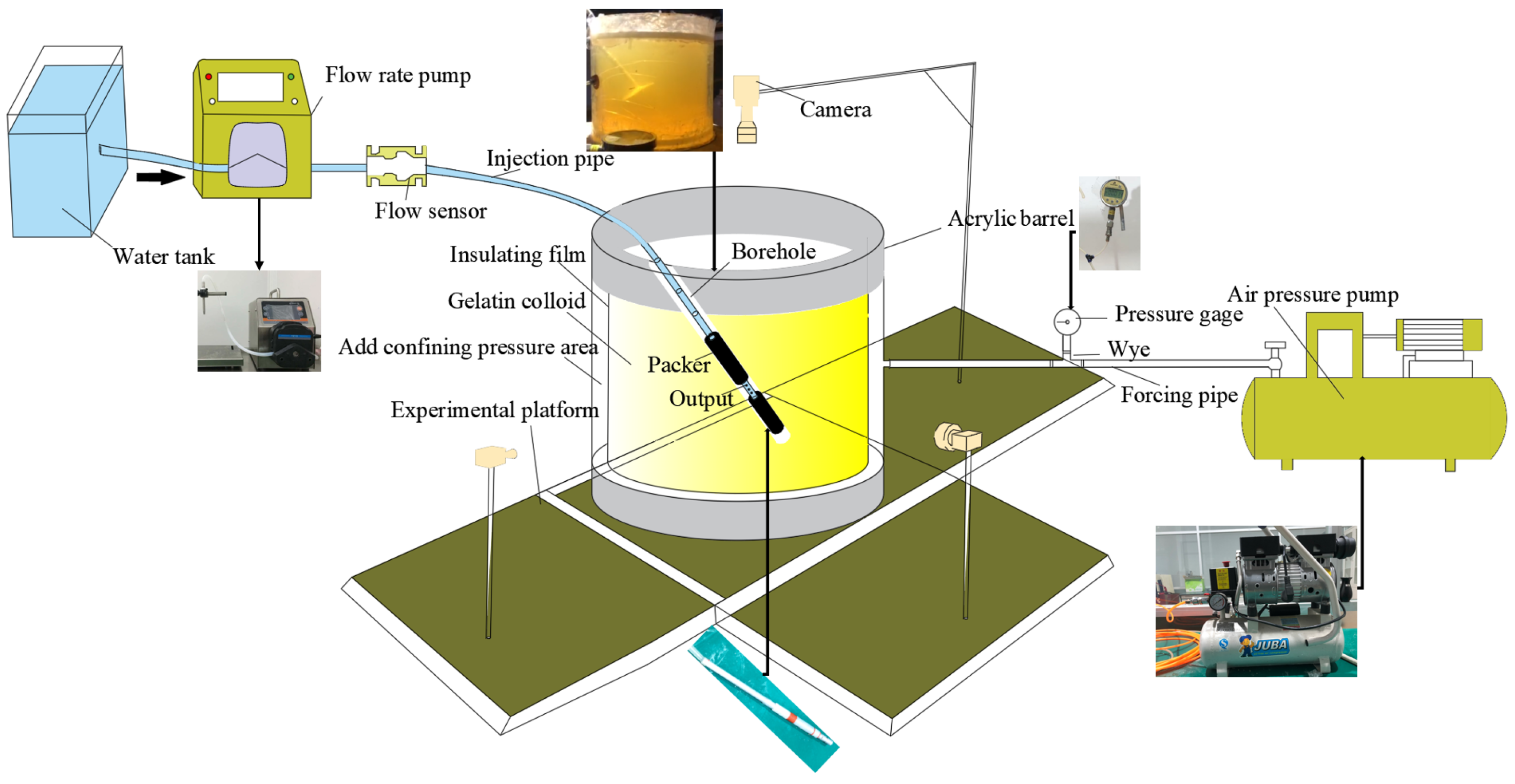
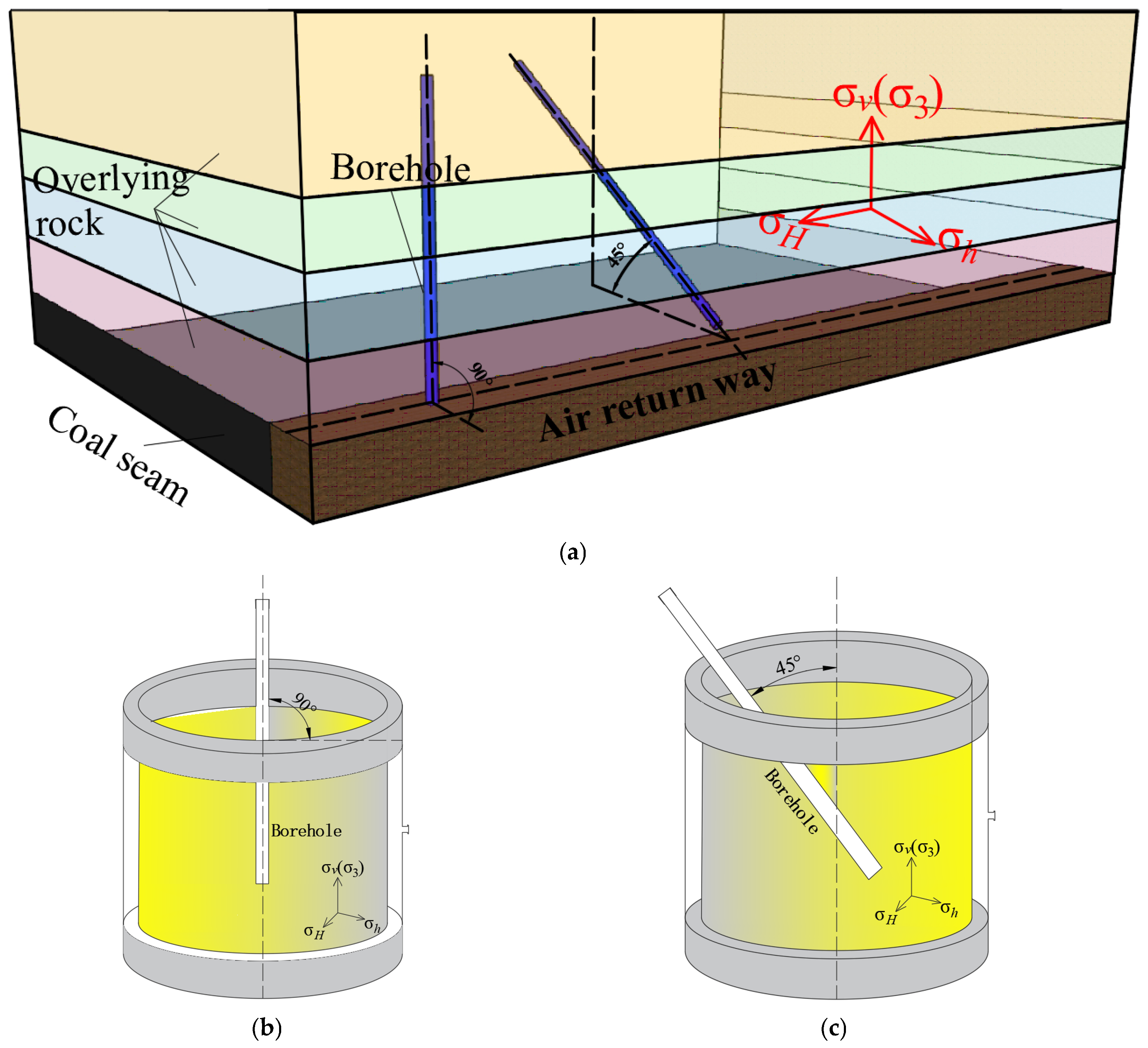

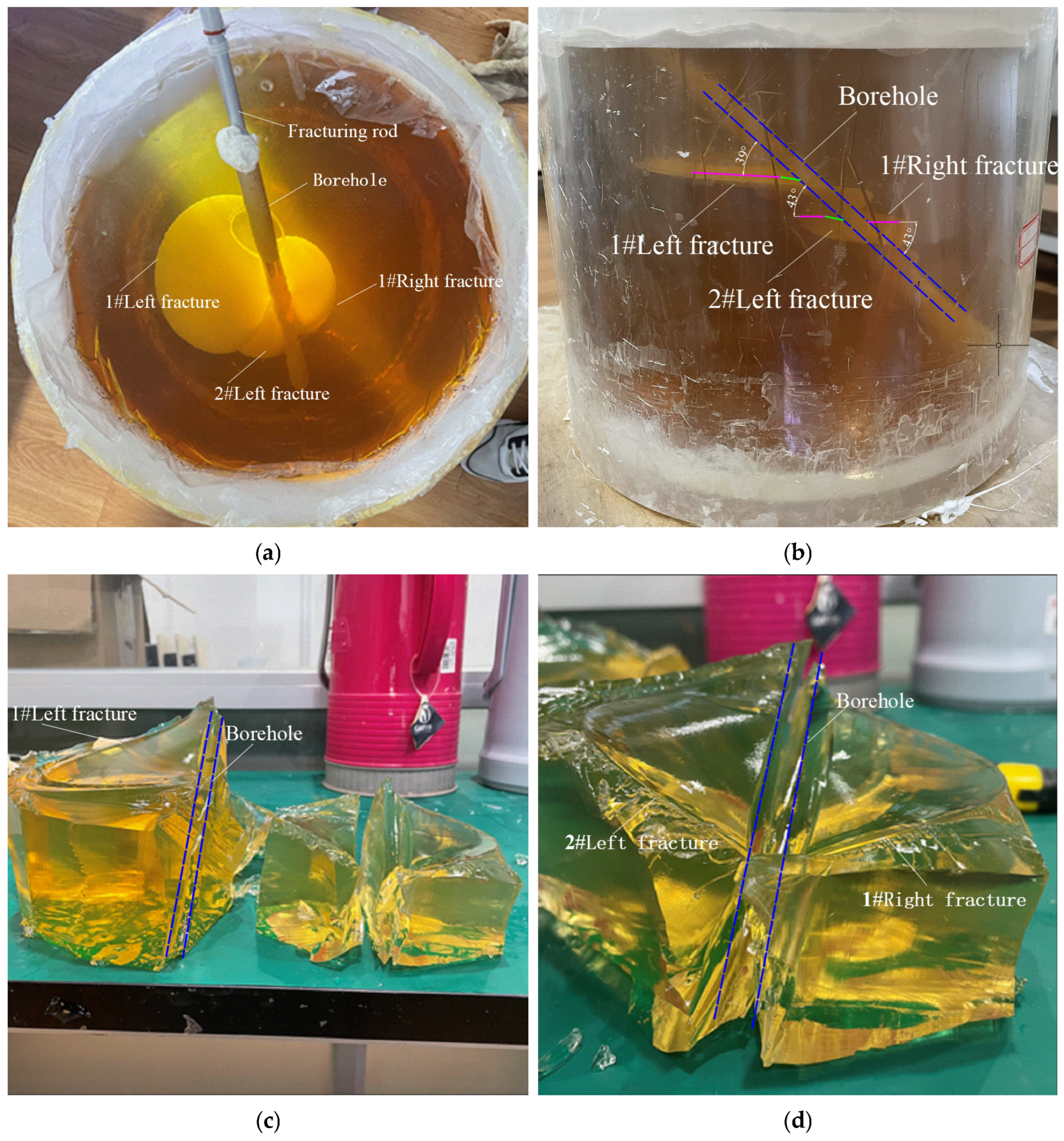
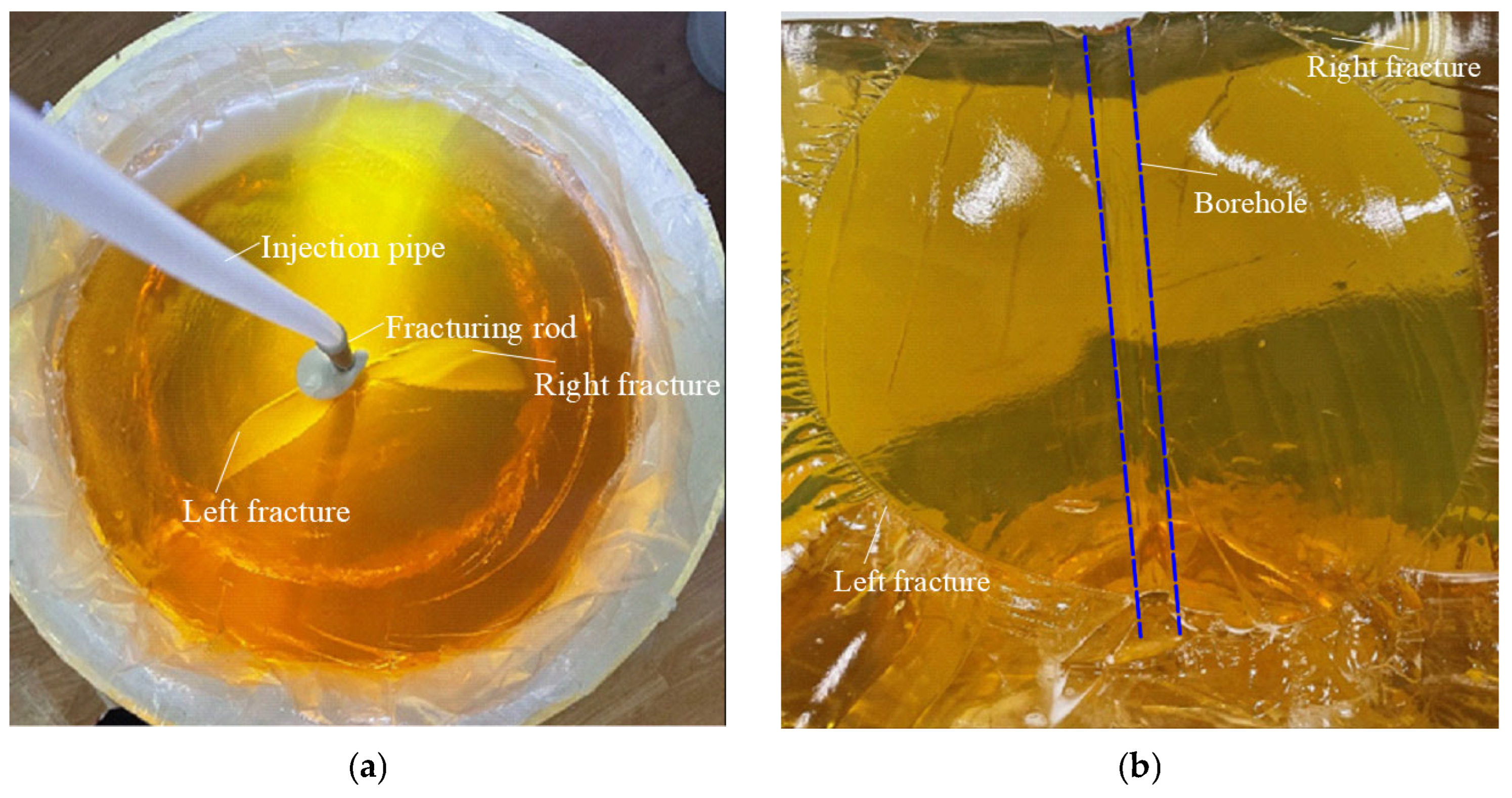
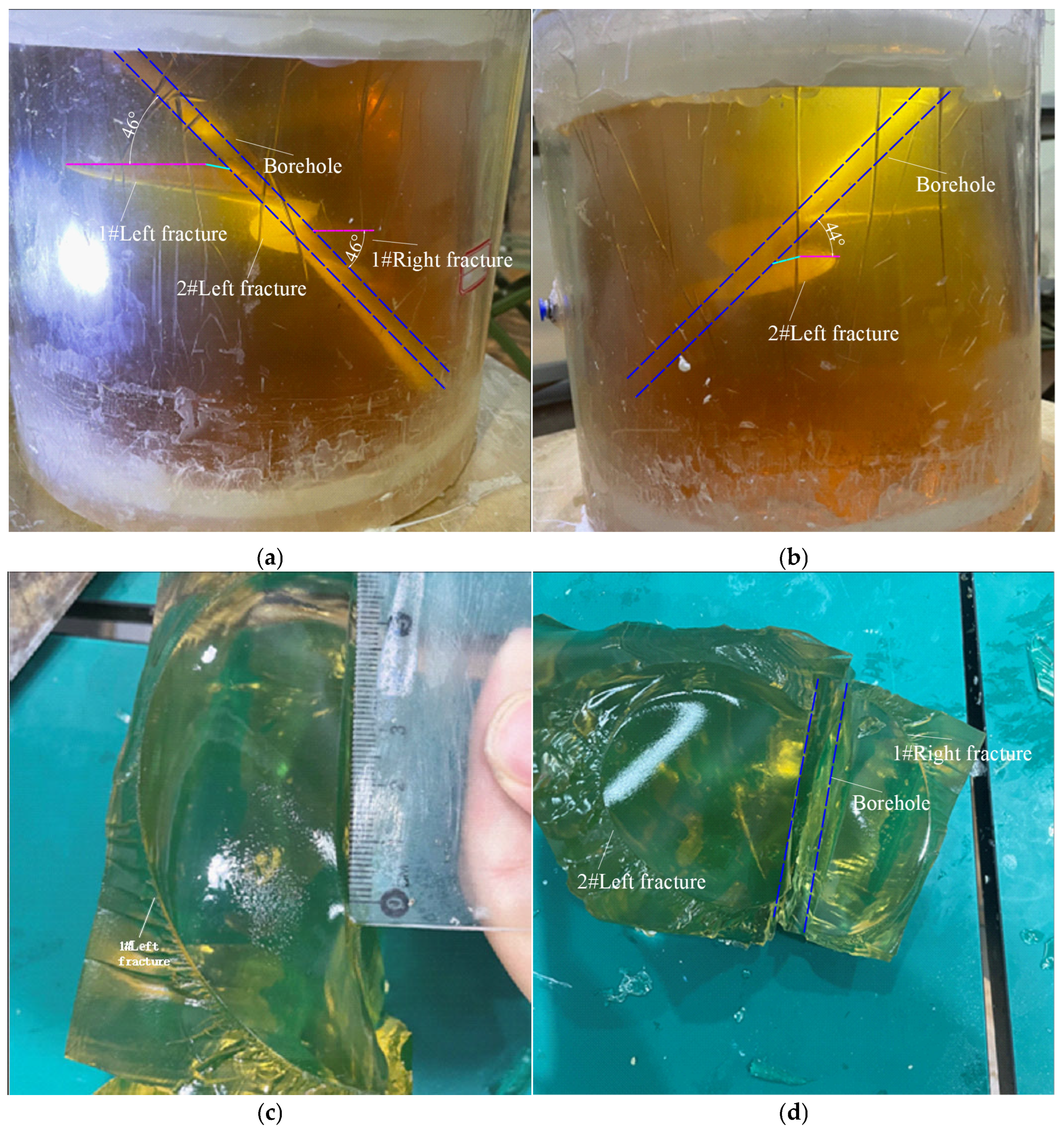

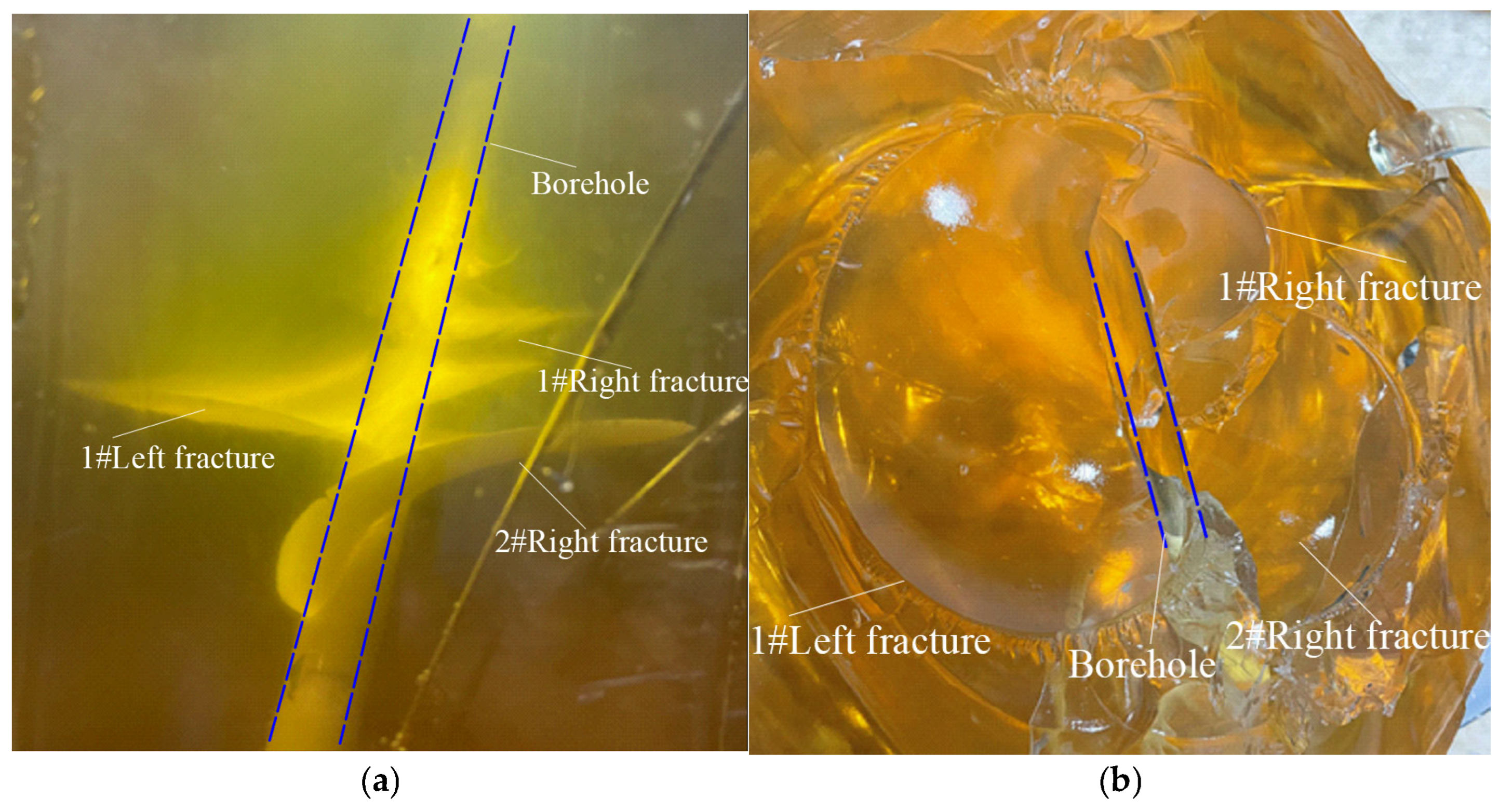
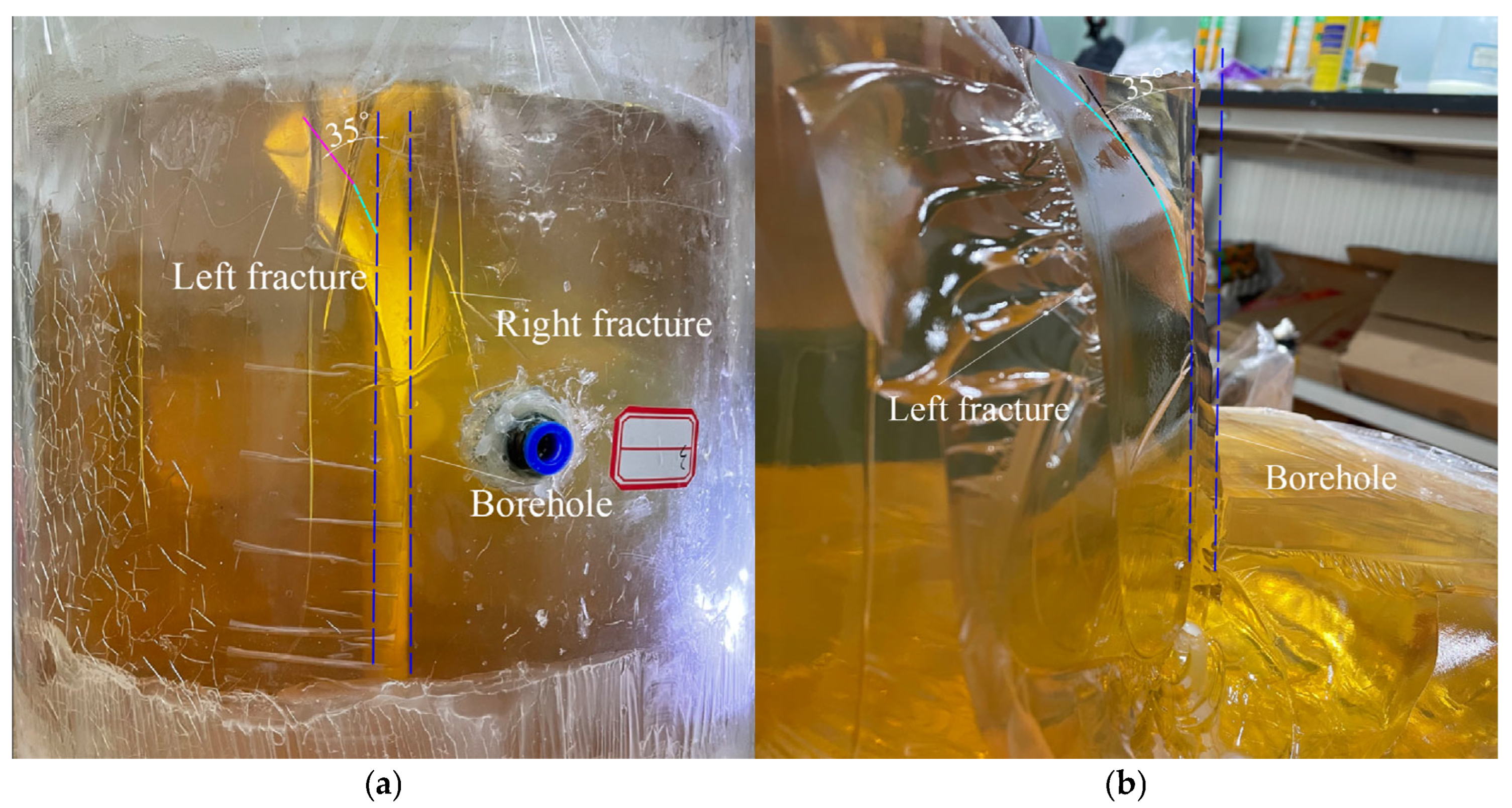
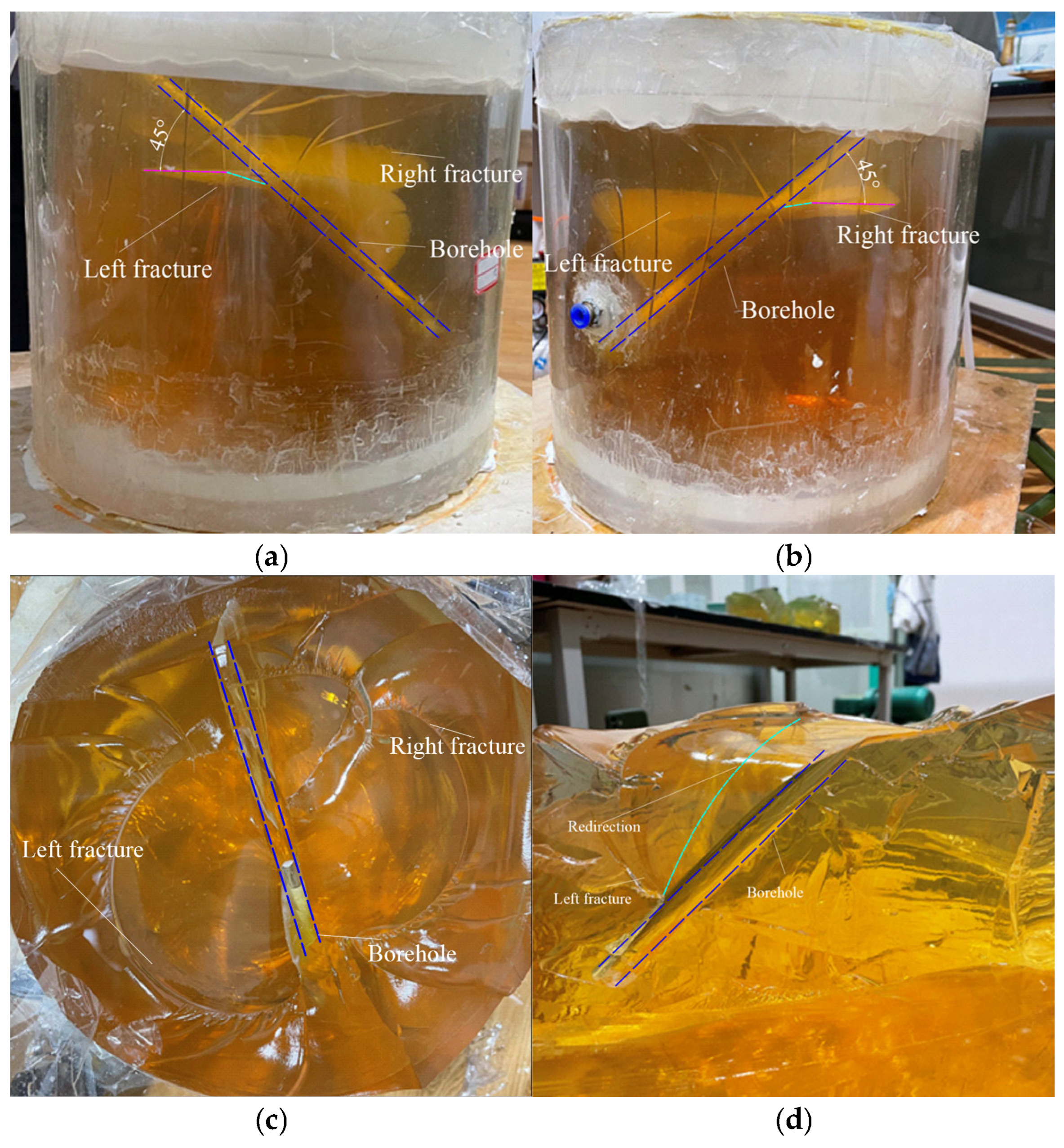
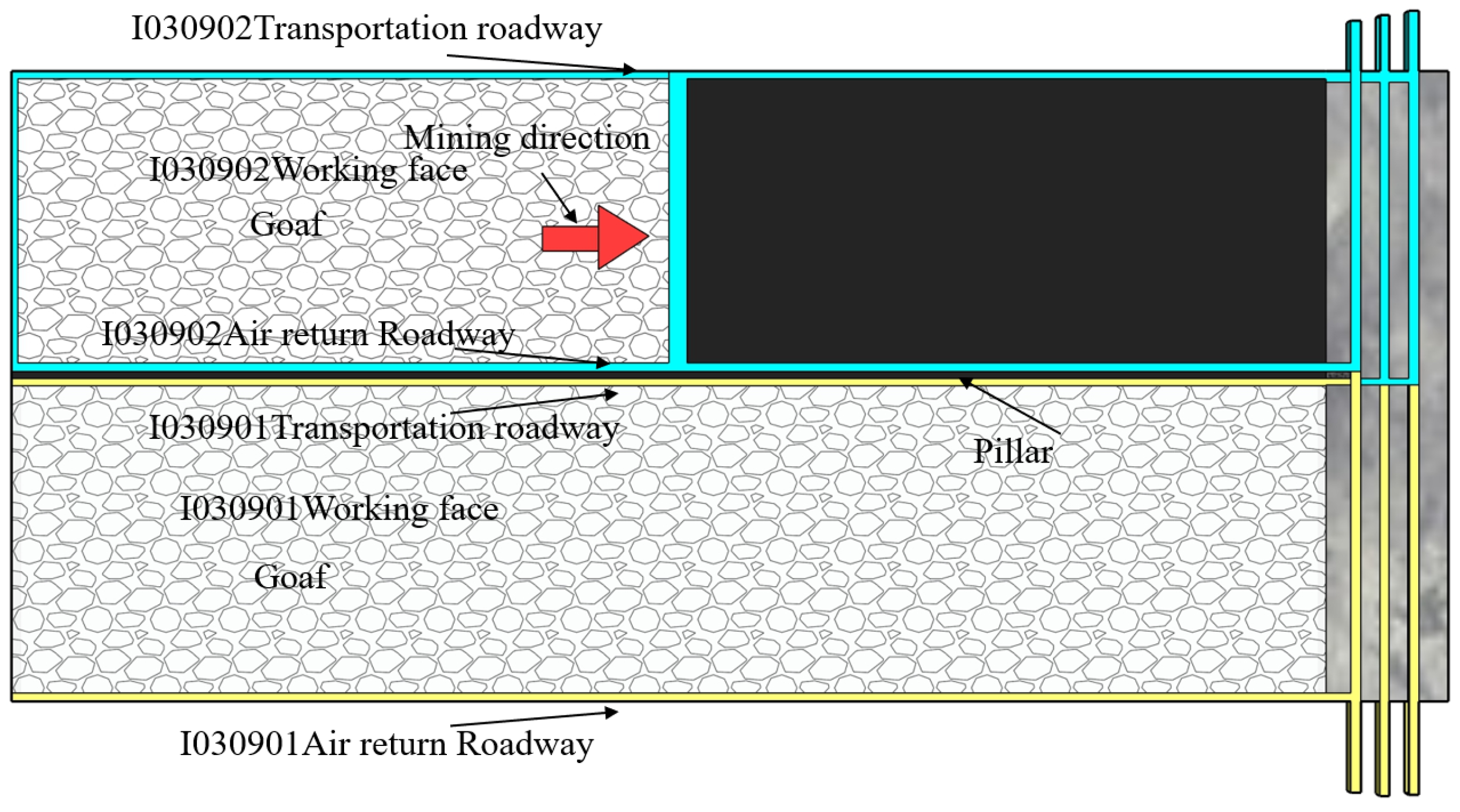
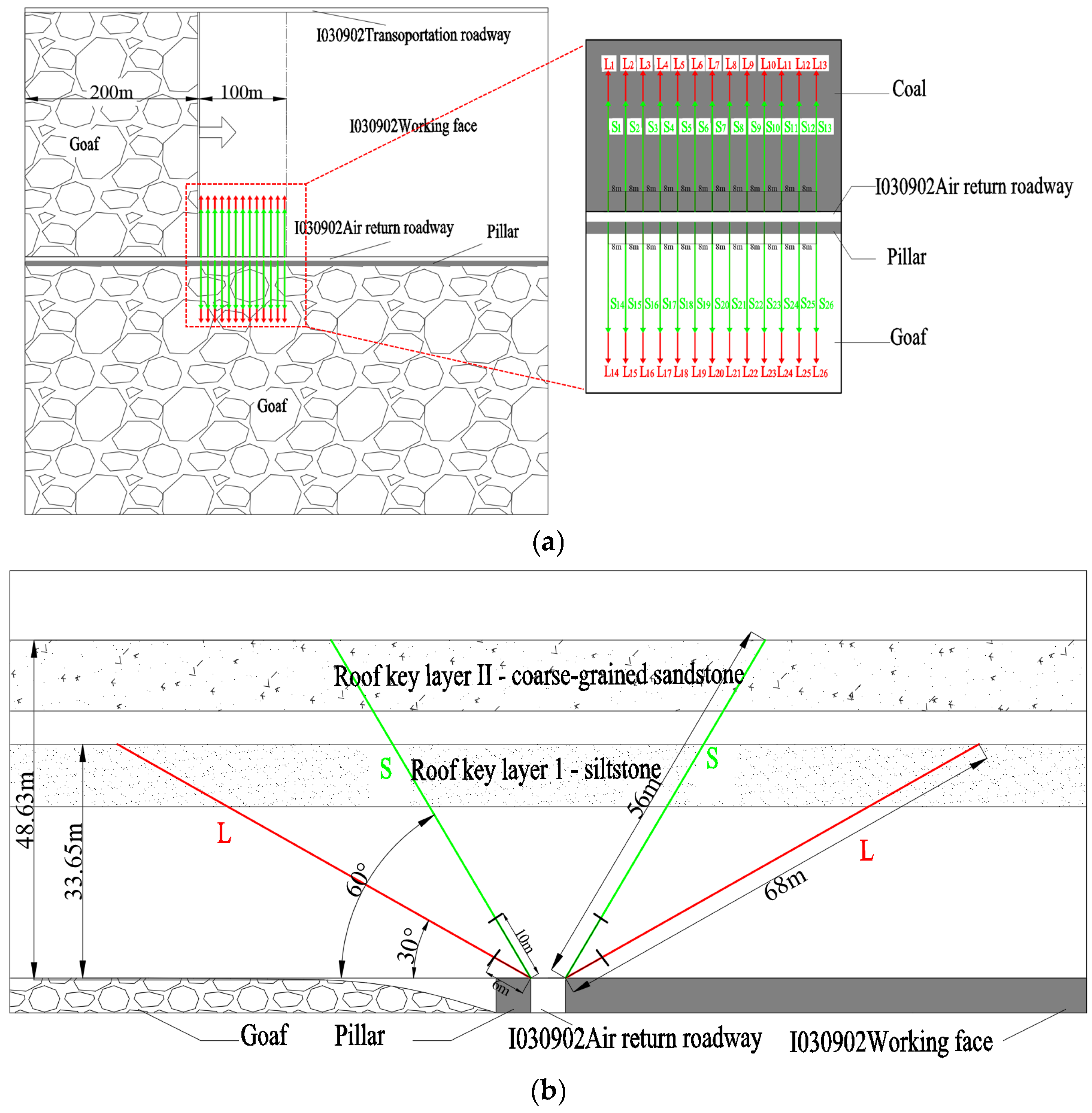


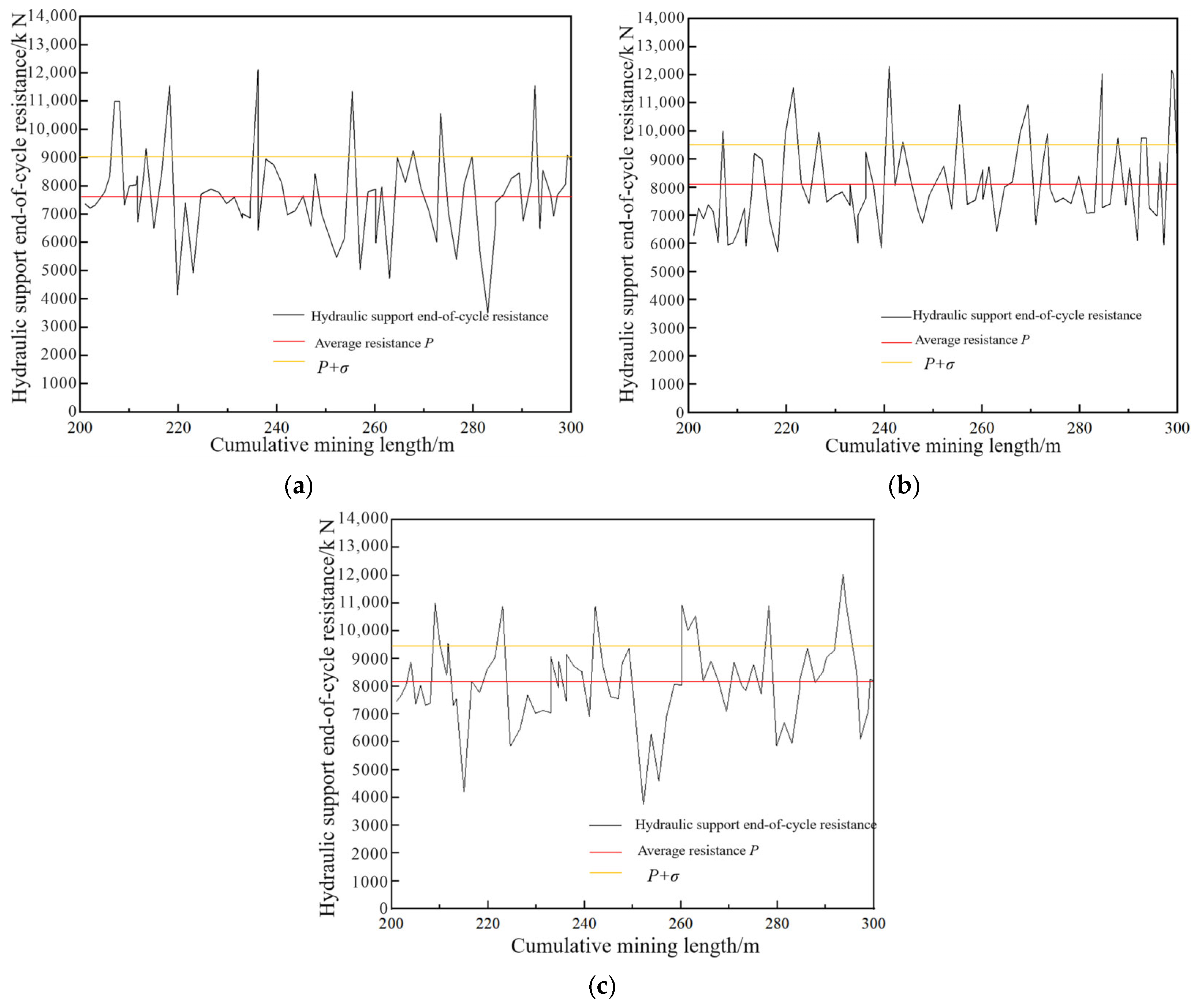
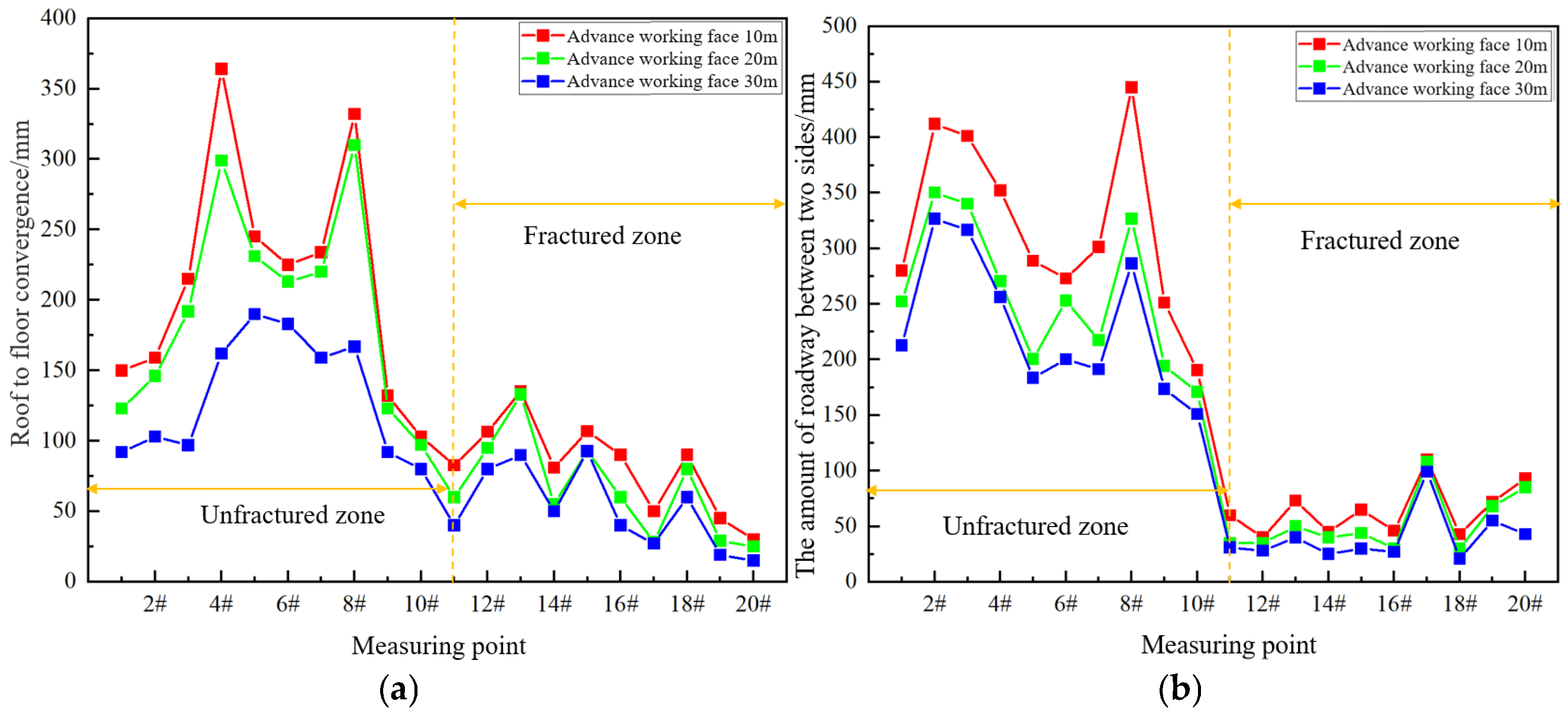
| Gelatin Sample Concentration (%) | Elastic Modulus of Gelatin (Pa) | Uniaxial Compressive Strength of Rock (MPa) | Apply Confining Pressure (Pa) |
|---|---|---|---|
| 8 | 38,605 | 45.58 | 4960 |
| 8 | 38,605 | 50.02 | 5800 |
| 6 | 22,491 | 45.58 | 3400 |
| 6 | 22,491 | 50.02 | 2800 |
| Case | Confining Pressure (Pa) | Concentration (%) | Dip Angle of Borehole (°) | Simulated Key Strata Serial Number |
|---|---|---|---|---|
| 1-1 | 5800 | 8 | 90 | first key strata |
| 1-2 | 5800 | 8 | 45 | first key strata |
| 1-3 | 4960 | 8 | 90 | second key strata |
| 1-4 | 4960 | 8 | 45 | second key strata |
| 2-1 | 3400 | 6 | 90 | first key strata |
| 2-2 | 3400 | 6 | 45 | first key strata |
| 2-3 | 2800 | 6 | 90 | second key strata |
| 2-4 | 2800 | 6 | 45 | second key strata |
| Type | Number | Borehole Depth (m) | Azimuth Angle (°) | Dip Angle (°) | Pitch of Boreholes (m) |
|---|---|---|---|---|---|
| L-borehole | 26 | 68 | 180° | 30 | 8 |
| S-borehole | 26 | 57 | 180° | 60 | 8 |
Disclaimer/Publisher’s Note: The statements, opinions and data contained in all publications are solely those of the individual author(s) and contributor(s) and not of MDPI and/or the editor(s). MDPI and/or the editor(s) disclaim responsibility for any injury to people or property resulting from any ideas, methods, instructions or products referred to in the content. |
© 2025 by the authors. Licensee MDPI, Basel, Switzerland. This article is an open access article distributed under the terms and conditions of the Creative Commons Attribution (CC BY) license (https://creativecommons.org/licenses/by/4.0/).
Share and Cite
Sun, T.; Li, Z.; He, Q.; Ma, D.; Liu, B.; Gao, X. Research on Hydraulic Fracturing Technology for Roof Stratigraphic Horizon in Coal Pillar Gob-Side Roadway. Appl. Sci. 2025, 15, 4759. https://doi.org/10.3390/app15094759
Sun T, Li Z, He Q, Ma D, Liu B, Gao X. Research on Hydraulic Fracturing Technology for Roof Stratigraphic Horizon in Coal Pillar Gob-Side Roadway. Applied Sciences. 2025; 15(9):4759. https://doi.org/10.3390/app15094759
Chicago/Turabian StyleSun, Tong, Zhu Li, Qingyuan He, Dan Ma, Benben Liu, and Xuefeng Gao. 2025. "Research on Hydraulic Fracturing Technology for Roof Stratigraphic Horizon in Coal Pillar Gob-Side Roadway" Applied Sciences 15, no. 9: 4759. https://doi.org/10.3390/app15094759
APA StyleSun, T., Li, Z., He, Q., Ma, D., Liu, B., & Gao, X. (2025). Research on Hydraulic Fracturing Technology for Roof Stratigraphic Horizon in Coal Pillar Gob-Side Roadway. Applied Sciences, 15(9), 4759. https://doi.org/10.3390/app15094759








